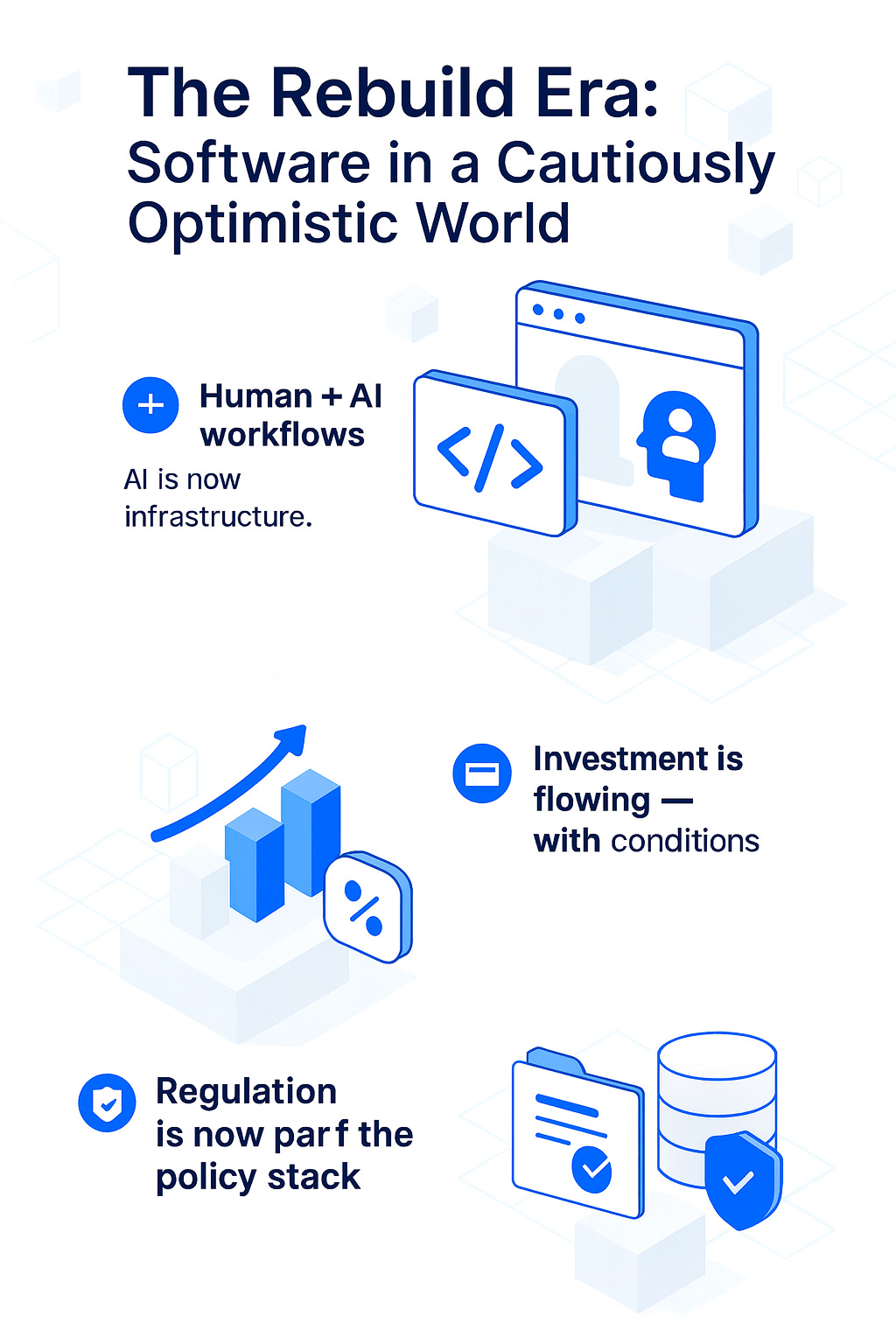The Rebuild Era: Software in a Cautiously Optimistic World
We’ve had the correction. We’ve had the freeze. Now, something else is happening.
It’s not the bull run of 2021, but it’s not the despair of 2023 either. Call it the rebuild era — a moment in global software development marked by recovery, reinvention, and restraint. The systems are moving again. Budgets are being unlocked. But they’re moving with intention.
This piece is a snapshot of where we are now:
What’s shaping software teams and the tech they’re building
How macroeconomics is subtly redrawing the map
What to expect from regulation, funding, and AI breakthroughs
And what the European perspective uniquely brings to the table
Let’s start with the obvious: the software world is speeding up again, but it’s taking a different route this time.
Human + AI workflows are the new normal
The AI “co-pilot” is no longer a novelty — it’s infrastructure.
From GitHub Copilot to Devin, Meta’s open-source Llama 3, and whatever OpenAI or Google are about to drop next, software developers are working side-by-side with code-generating systems that don’t sleep. These tools are writing tests, translating between languages, finding bugs. And they’re getting smarter fast.
But the real shift isn’t technical — it’s cultural.
Teams are starting to design their entire workflows around AI, treating it like a junior dev you don’t have to onboard. AI tools aren’t replacing people, but they are compressing timelines, flattening hierarchies, and demanding new skill sets (like prompt design or AI verification).
Europe is playing this cautiously. Compliance-first cultures, tighter regulation (more on that below), and trust-driven markets mean AI tools are deployed with more guardrails — and more transparency. It slows things down, maybe. But it also builds systems that last.
“The best EdTech product is invisible.” — Marcin Demkowicz, ShareTheBoard (link)
The same principle holds beyond education. The best AI? Probably the one your user doesn’t notice.
Macro forces are finally favoring smart tech again
After two years of inflation, interest rate hikes, and startup belt-tightening, IT spending is growing again — up nearly 10% YoY globally, according to Gartner. But unlike the cheap-money era, today’s investments come with questions: Is it secure? Compliant? Productive?
The answers explain the winners of 2025 so far:
Enterprise software tied to automation, cost efficiency, or regulatory compliance
AI infrastructure (chips, data centers, dev tools)
Companies that sell trust, not just speed
In parallel, VC funding is up, but concentrated:
Over 50% of global venture capital in H1 2025 went into AI startups. North America is leading. Europe is lagging.
And that’s not just because of fewer unicorns — it’s because the continent still funds more through public grants and corporate R&D than mega venture rounds.
Europe’s advantage lies elsewhere: friendshoring, talent reliability, compliance leadership. More on that here. In a risk-sensitive world, trust is a feature.
Software funding is back — with conditions
Yes, the money is flowing again.
But not for everyone.
Funding is rising, especially in AI-related tools, infrastructure, and enterprise SaaS. Yet Europe’s slice of that pie has shrunk — down to 13% of global VC in H1 2025, from nearly 20% a year earlier. Why? Less hype, more caution, fewer mega-deals.
Still, capital is returning. IPO windows are cracking open. M&A activity is surging. And most importantly: internal tech budgets inside enterprises are growing again. In other words, even if you're not raising, you might still be building.
Regulation is now part of the stack
By the end of 2025, the EU’s AI Act will be in full swing.
It bans certain high-risk uses, mandates documentation and human oversight, and forces transparency for foundation models.
If GDPR was the template for data, the AI Act may become the template for trust. And like with GDPR, global companies will comply — even if only one market requires it.
For European teams, this isn’t new. They’ve long had to design around constraints. The difference now? That constraint is a market differentiator.
From the interviews: trust, UX, and the soft edge of EdTech
In our EdTech Dots series, three conversations stood out:
Marcin Demkowicz (ShareTheBoard) – built a tool that makes any whiteboard remote-friendly, without asking teachers to change habits. "Most EdTech solves problems created by earlier EdTech." (link)
Zoltán Visy – ex-creative director, now using AI to make lessons dynamic, visual, responsive. “80% can be automated. The last 20% — empathy, mentorship — is human.” (link)
Sebastian Białas (Edubba) – UX designer turned founder. His AI lesson-builder tool lives inside teachers’ daily workflow. If it’s not simple, it won’t ship. (link)
Each interview echoed a theme: tech should fit the system, not the other way around.
And that’s not just an EdTech lesson — it’s a software lesson.
Where we're going
Software is speeding up.
Teams are leaner. Tools are smarter. The wave of AI-native software is real, and it’s cresting. But this time around, we’re building with a different mindset.
Not “move fast and break things.”
More like “move smart and integrate deeply.”
This is especially true in Europe, where funding may lag but trust, UX, and systems thinking lead.
The world isn’t looking for more features — it’s looking for fit.
Not more tools — but the ones that make sense in a world that’s rebuilding.
Now’s a good time to be building.
Just build something people can actually use — and trust.


